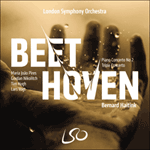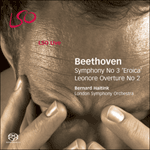
Welcome to Hyperion Records, a British classical label devoted to presenting high-quality recordings of music of all styles and from all periods from the twelfth century to the twenty-first.
Hyperion offers both CDs, and downloads in a number of formats. The site is also available in several languages.
Please use the dropdown buttons to set your preferred options, or use the checkbox to accept the defaults.

| London Symphony Orchestra, Bernard Haitink (conductor)» More |
The four versions of the overture are sufficiently different to suggest that Beethoven’s doubts were not so much with musical quality as with function. His original intention was clearly to provide a programmatic prelude that would foreshadow the ensuing drama and its music in the manner of the overtures of contemporary French opera. That to the 1805 version (known as Leonore No 2) is grand and dramatic but architecturally loose, and for the 1806 revision Beethoven produced Leonore No 3 which, while retaining much of the material of the original, was more concise and formally directed. Both the subsequent Leonore No 1 and Fidelio overtures, however, are shorter and in lighter, more independent vein, and while we may therefore assume that Beethoven found Nos 2 and 3 overbearing in their operatic settings, it is precisely the balance these closely related works strike between forceful dramatic suggestion and structural clarity that has made them the more popular of the Leonore/Fidelio overtures in the concert hall. As such, they are effectively the ancestors of the nineteenth century tone poem.
The opera is based on a true incident which occurred during the French Revolution: Florestan, a political prisoner, is aided in his escape by his wife Leonore, who has courageously taken a job as a prison guard while disguised as a man named Fidelio. Leonore No 2 suggests these events with powerful simplicity. A slow, harmonically groping introduction shows us the dungeon, with Florestan’s presence indicated by a reference on clarinets, horns and bassoons to his despairing aria from the beginning of Act 2. When the fast section arrives, it is with a leaping, heroic tune for Leonore which then leads to a warmly romantic transformation of Florestan’s aria. Later Beethoven imports a dramatic stroke directly from the opera: two off-stage trumpet calls signalling the pair’s imminent rescue, before the overture ends in a mood of emphatic joy.
from notes by Lindsay Kemp © 2005
Les quatre versions de l’ouverture diffèrent suffisamment pour laisser penser que les doutes de Beethoven ne concernaient pas tant la qualité musicale que la fonction même des morceaux. A l’évidence, son intention originelle était de composer un prélude à programme qui préfigurât le drame à venir et la musique qui l’accompagnait, à la manière des ouvertures que l’on trouvait dans l’opéra français contemporain. L’ouverture conçue pour la version de 1805 (connue sous le titre de Leonore II) est grandiose et dramatique, mais son architecture est lâche; pour la révision de 1806, Beethoven écrivit l’ouverture Leonore III qui, tout en reprenant une bonne part du matériau musical de l’original, était plus concise et d’une forme mieux maîtrisée. Les deux ouvertures postérieures, Leonore I et Fidelio, sont toutefois plus courtes et dans une veine plus légère, moins liées au drame; et si, pour cette raison, nous pouvons estimer de bon droit que Beethoven jugea les numéros 2 et 3 trop impérieux pour le cadre d’un opéra, c’est précisément l’équilibre dont témoignent ces deux pages, clairement parentes, entre la force de suggestion dramatique et la clarté structurelle qui en a fait les plus populaires, au concert, des quatre ouvertures Leonore/Fidelio. En tant que telles, elles sont en effet les ancêtres du poème symphonique du XIXe siècle.
L’opéra repose sur un épisode véridique de la Révolution française: Florestan, un prisonnier politique, est aidé dans sa fuite par son épouse Léonore, qui s’est courageusement fait engager comme gardien de prison, déguisée en homme sous le nom de Fidelio. Leonore II évoque ces événements avec simplicité et puissance. Une introduction lente à l’harmonie incertaine nous dépeint le donjon, la présence de Florestan étant indiquée par une référence, aux clarinettes, cors et bassons, à son air désespéré du début de l’acte II. Lorsque arrive la section vive, c’est au son d’une mélodie bondissante et héroïque associée à Léonore, qui mène ensuite à une variante chaleureuse et romantique de l’air de Florestan. Plus tard, Beethoven importe un coup de théâtre directement de l’opéra: deux appels de trompette en coulisse signalent que le couple va être sauvé de manière imminente, et l’ouverture s’achève dans une joie pleine d’emphase.
extrait des notes rédigées par Lindsay Kemp © 2005
Français: Claire Delamarche
Die vier Fassungen der Ouvertüre sind ausreichend unterschiedlich, dass sie die Annahme rechtfertigen, Beethovens Zweifel hätten sich weniger um musikalische Qualität als um Funktion gedreht. Ursprünglich hegte er offensichtlich die Absicht, ein programmatisches Vorspiel zu liefern, welches im Stile der damaligen französischen Opernouvertüren das bevorstehende Drama und dessen Musik vorwegnehmen sollte. Das Vorspiel zur 1805er Fassung (als Leonoren-Ouvertüre Nr. 2 bekannt) ist grandios und dramatisch, aber seine Architektur ist locker. Für die 1806er Fassung schuf Beethoven die Leonoren-Ouvertüre Nr. 3, die, auch wenn sie immer noch einen Großteil des originalen Materials enthält, einen viel bündigeren und formal stärker ausgerichteten Eindruck hinterlässt. Sowohl die darauf folgende Leonoren-Ouvertüre, die tatsächlich als Nr. 1 bezeichnet wird, wie auch die Fidelio-Ouvertüre sind noch kürzer und wirken leichter und unabhängiger. Zwar können wir annehmen, dass Beethoven die Ouvertüren Nr. 2 und 3 mit ihrem Operngestus als zu theatralisch empfand. Aber genau die Balance, die diese eng verwandten Werke zwischen kräftigem, dramatischem Gestus und struktureller Klarheit halten, führte dazu, dass sie sich unter den Leonoren/Fidelio- Ouvertüren im Konzertsaal einer größeren Beliebtheit erfreuen. Als solche theatralischen Konzertstücke sind sie gewissermaßen Vorläufer der sinfonischen Dichtung des 19. Jahrhunderts.
Die Oper beruht auf einem wahren Ereignis aus der Französischen Revolution: Florestan, ein politischer Gefangener, wird von seiner Frau Leonore zur Flucht verholfen. Verkleidet als Mann hat sie unter dem Decknamen Fidelio mutig einen Dienst als Gefängniswärter angenommen. Die Leonoren-Ouvertüre Nr. 2 zeichnet diese Ereignisse mit beeindruckender Einfachheit nach. Eine langsame, harmonisch blind tastende Einleitung verweist auf einen Kerker. Die Gegenwart Florestans wird von den Klarinetten, Hörnern und Fagotten mit einem Hinweis auf Florestans verzweifelte Arie aus dem Beginn des zweiten Akts angedeutet. Der sich daran anschließende schnelle Abschnitt zeichnet sich durch eine springende, heroische Melodie für Leonore aus, die dann in eine warm romantische Transformation der Florestanarie übergeht. Später übernimmt Beethoven einen dramatischen Moment direkt aus der Oper: zwei Trompeten hinter der Bühne kündigen die bevorstehende Rettung des Paares an. Darauf endet die Ouvertüre in einer Stimmung emphatischer Freude.
aus dem Begleittext von Lindsay Kemp © 2005
Deutsch: Elke Hockings
 Beethoven: Piano Concerto No 2 & Triple Concerto Beethoven: Piano Concerto No 2 & Triple ConcertoLSO Live celebrates the 90th birthday of one of the conducting world’s greats. This all-Beethoven album brings together Bernard Haitink's 2013 recording of the triumphant Piano Concerto No 2 (with Maria João Pires) and a virtuosic performance ...» More |
 Beethoven: Symphony No 3 Beethoven: Symphony No 3Beethoven took a massive stride forward in the development of the symphonic form with the 'Eroica'. Not only is the work written on an unprecedented scale, it also lays the very foundations of Romanticism in music.The symphony mirrors Beethoven's ...» More |

